We are planning to go to Sal, in the archipelago of Cape Verde Islands, sooner or later, since it's clear that it has a huge potential for windsurfing, and especially for waveriding.
Windsurfing spot review: Sal, Cape Verde Islands
(Podcast of the article, available below)
So, we started gathering some information about this travel, such as windsurfing spots, accomodation, flights, rental cars. We think it's helpful to share what we've discovered so far, just in case you're thinking about doing the same trip. If you have more information, write it in the comments at the end of this article.
Let's begin to understand why to go there for windsurfing, i.e. which are the spots characteristics, We've found very precious information on Josh Angulo Center website, which we report here. Josh Angulo Center is also a good choice for equipment renting, and accomodation.
Here below, we report Angulo's tips about spots.
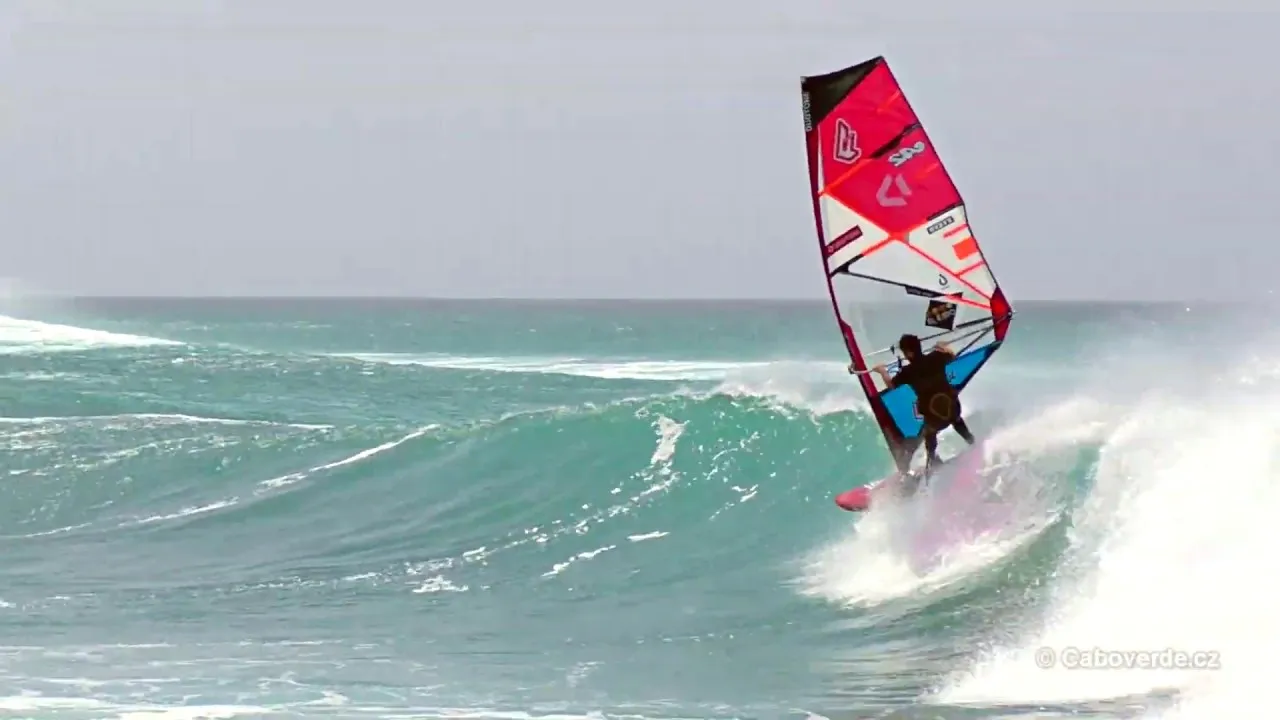
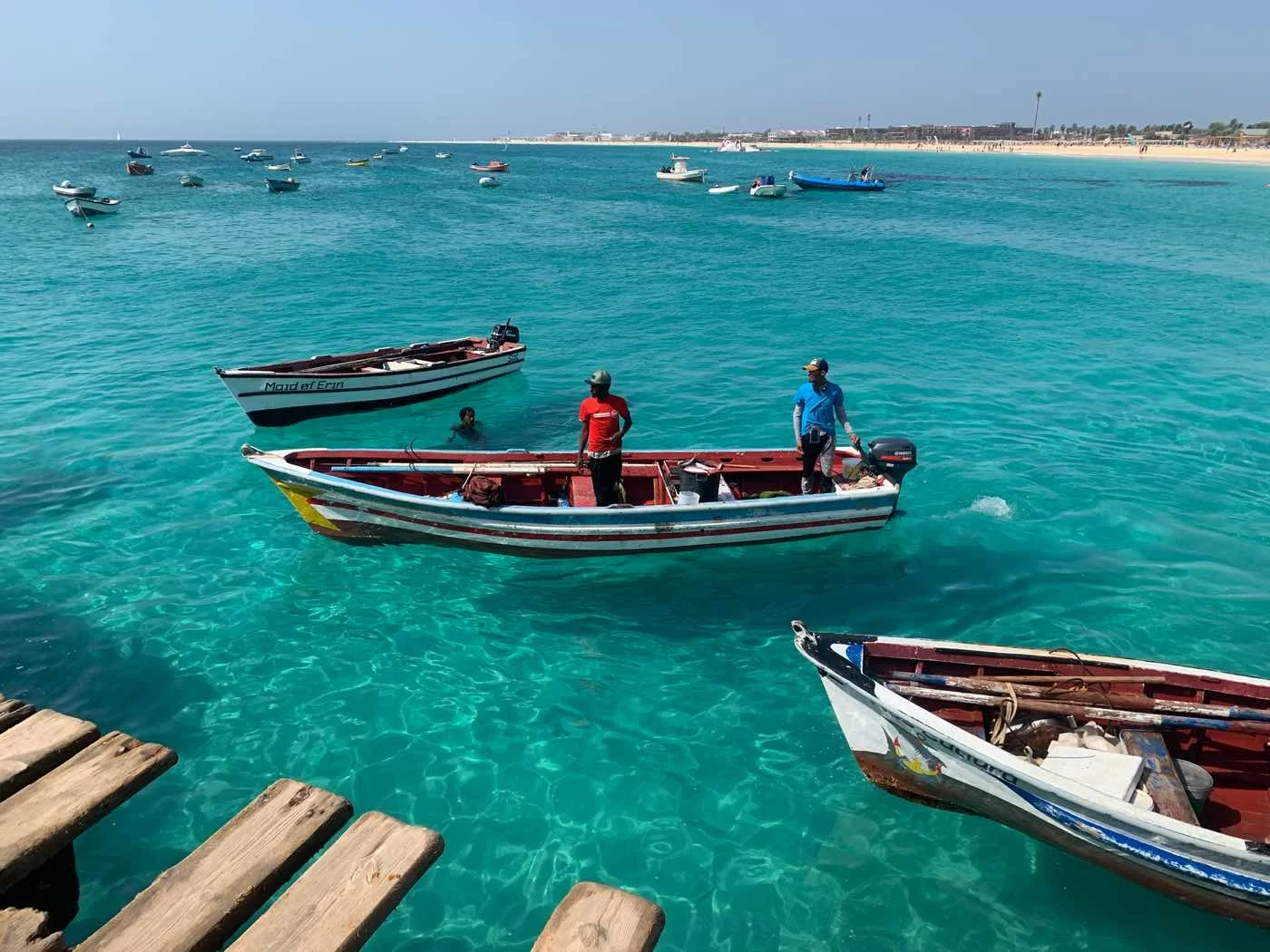
(Podcast of the article, divided in three parts)
General spots overview
After almost 10 years living in Sal and windsurfing and surfing all over the island, Jean-Sebastien and Marina Lange have created the ultimate guide to windsurfing in Sal.
This guide isn’t aimed at providing you with all the information for each spot, but rather to give you the desire to get away from the crowd and discover your own perfect spot.
What is the best period for wind?
While you occasionally have wind all year long, the trade winds usually start blowing in mid-November until June. The wind is often light (14-20 knots) but is usually stronger from mid-January to March / April (up to 25-30 knots). We rarely get anything stronger than this.
What is best period for waves?
The first swells arrive in October and become more and more frequent. The biggest swells are from December to March. You can still catch a good north-west swell in April and May. In the summer you can sometimes catch some swell from the south, which are smaller but still great.
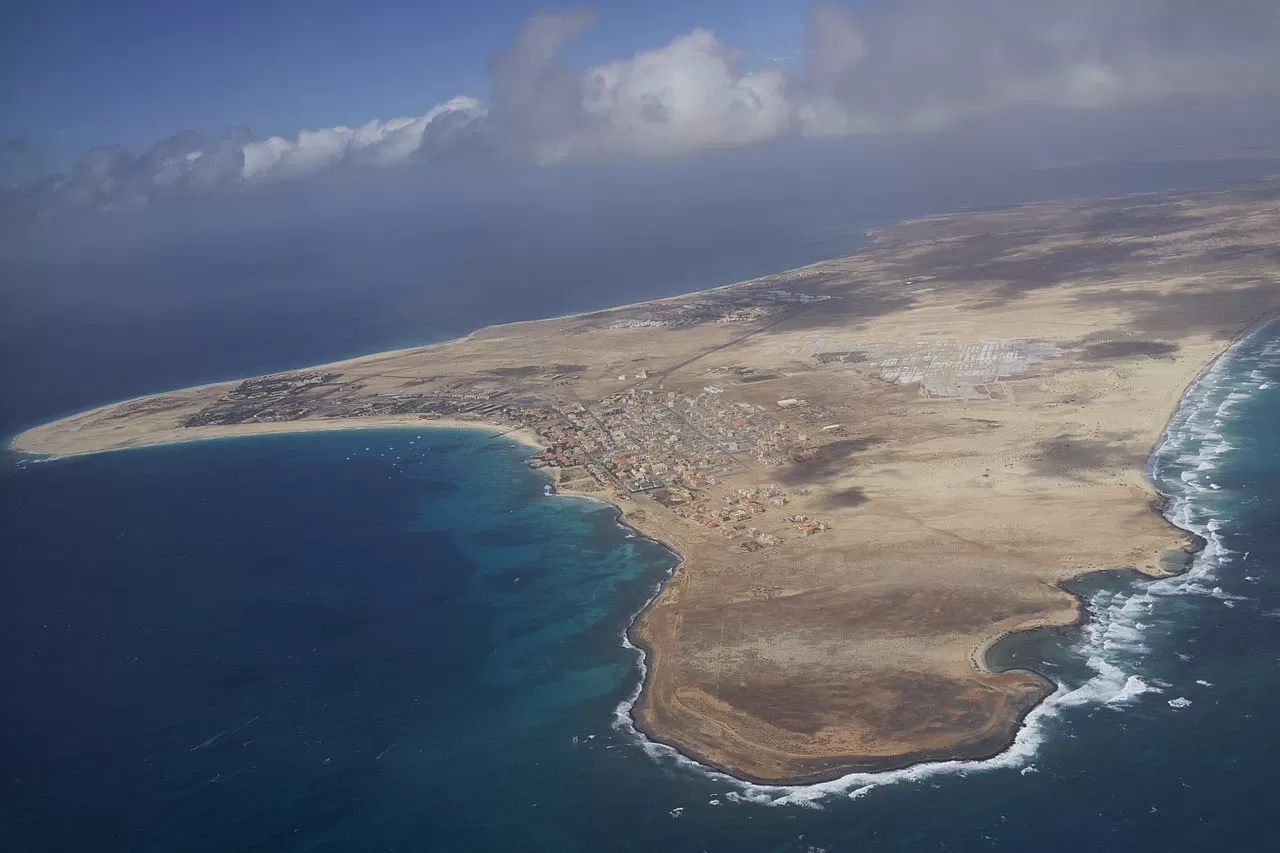
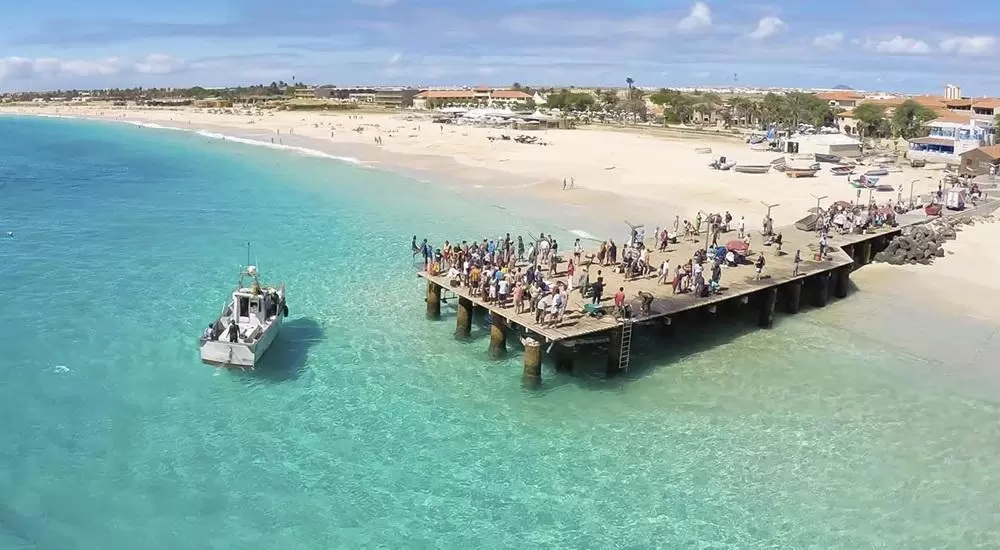
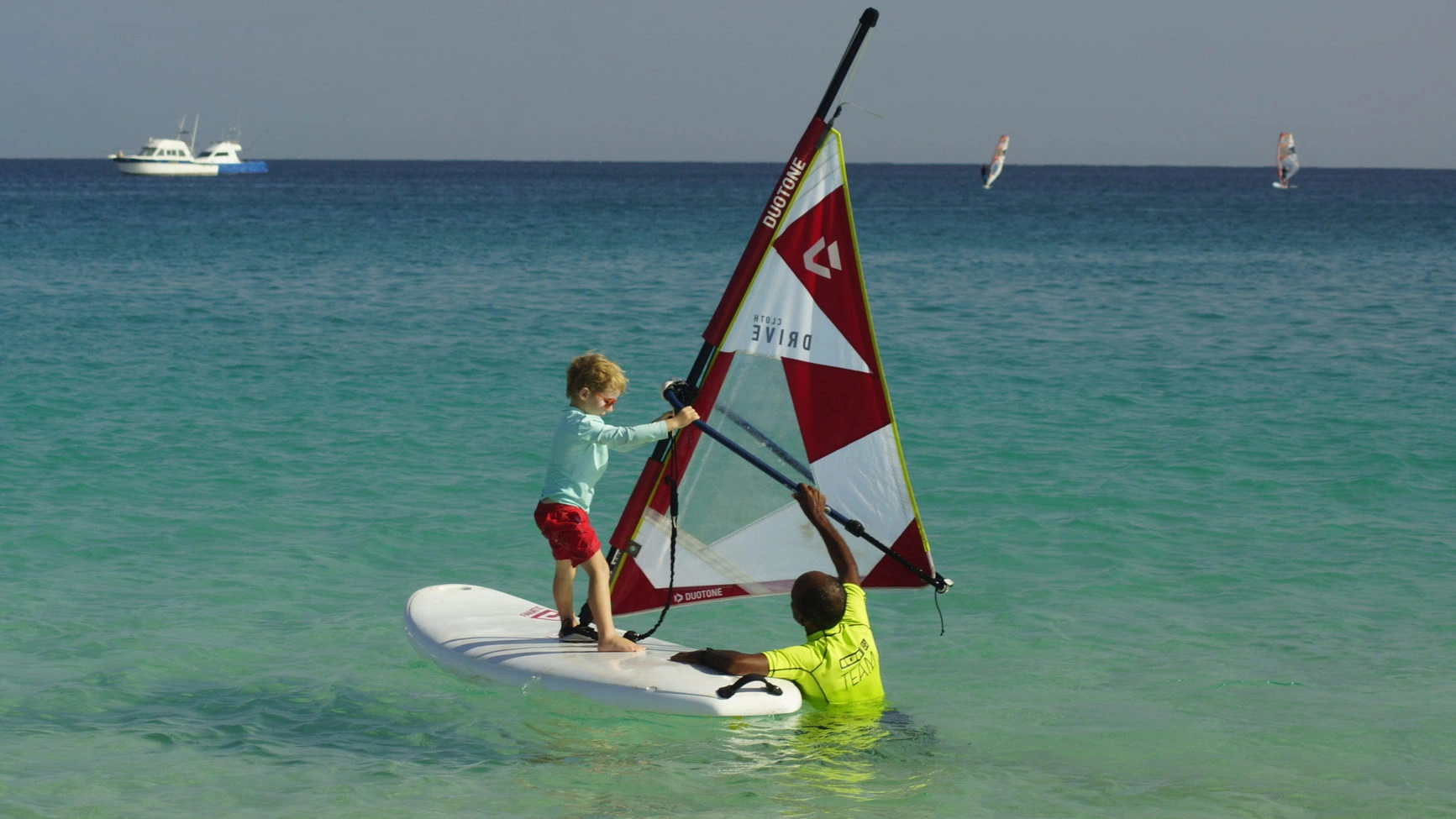
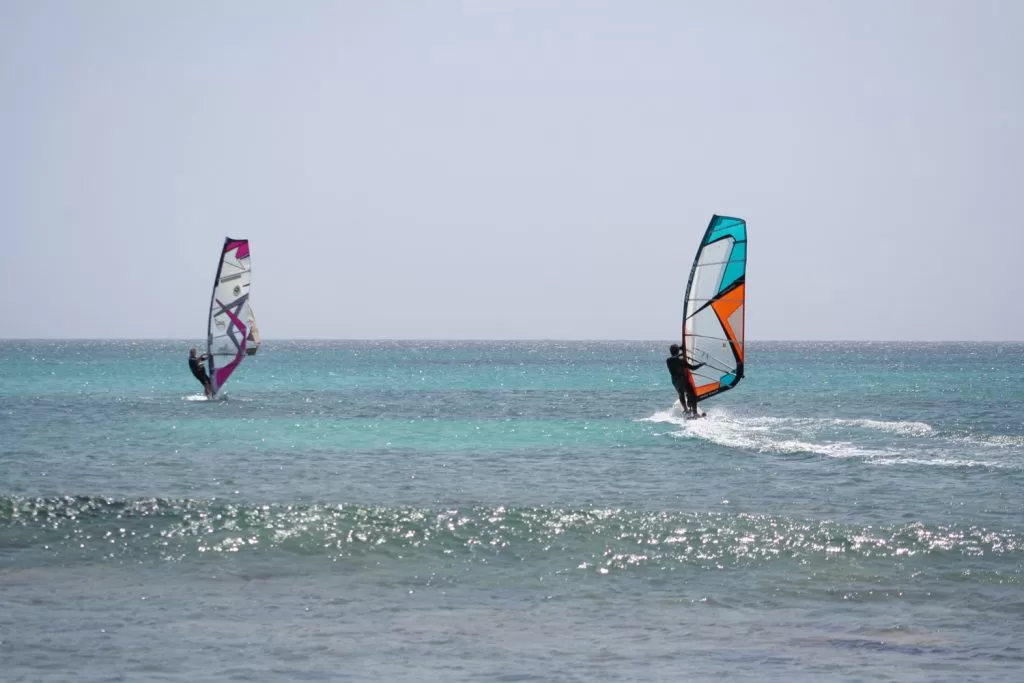
Santa Maria
The bay of Santa Maria faces the south. The wind here is port-tack, side-off shore. You need to be careful on these spots because they seem to be very safe but if you have a problem or break something, the next stop is probably Brazil! (Don’t panic – we do have a jet-ski!).
East Coast
The wind on the East Coast spots is port tack onshore to side-onshore. The waves are usually not too powerful and the spots are safe. When there is no swell but medium to strong wind, this coast can catch some rather good wind swell. Generally the conditions are more or less like Europe… But with sun, turquoise warm water and trade winds!
West Coast
Now we are talking about WAVES. While other spots on the East and South coasts can get some pretty big waves, they are still safe. But when the swell comes in from the North West, these spots on the West coast can be dangerous.
Santa Maria
The bay of Santa Maria faces the south. The wind here is port-tack, side-off shore.
You need to be careful on these spots because they seem to be very safe but if you have a problem or break something, the next stop is probably Brazil! (Don’t panic – we do have a jet-ski!)
There are some very different spots in this bay – far more that you first imagine. You will find some good waves here when the swell comes from the South or from the North (wind swell).
1. Ponta Leme (aka Ponta Este)
This is probably the easiest wave in Sal. To windsurf here you need to start from our Center and sail upwind. The wind is usually side to side-on shore and the waves are not very powerful. If you are not confident with your wave riding this is the place for you. Even when the swell is getting bigger, the waves are still easy to ride – safe and danger-free. The wave can be surfed both back side and front side. This is also a very good spot for jumping. There is a lot of flat water in front of the waves, so you can get full speed on the wave for some very high jumps!
A few days of strong winds will create a wind swell from the North-West and Ponta Leme is one of the first spots the waves will reach.
2. Ponta Leme’s Left
Just a few hundred metres before Ponta Leme, there is a small point where the wave is hollow and, therefore, more powerful. This small wave is not for everybody, especially when it is small and breaks just in front of the rocks. The wind here is side-off shore, which is great for wave riding but unfortunately it is often irregular and lighter in the wave. The waves here are inconsistent during the day as it depends on several elements – particularly the tide. When the conditions are good, enjoy them. When they are not working, you should come back a couple of hours later to check how it is going! When the swell gets bigger, you can catch a wave at Ponta Leme and ride it up to here. The length of the wave increases with its size. After a certain size, the wave can even connect up with Wave Power.
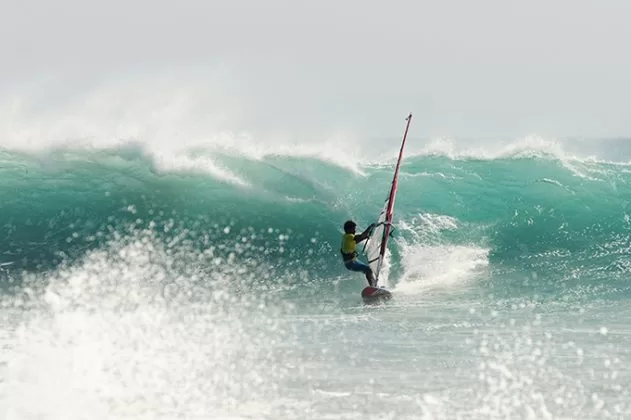
3. Wave Power
OK – it is a long story how this spot got it’s name – and unfortunately it has nothing to do with powerful waves… Anyway, this is not a long wave but form time to time there is a good hollow bowl here which can be really great for aerials.
4. Club Angulo
This is probably where you will start you windsurfing experiences of Sal’s different spots – right in front of our Centre. From here you can go upwind to Ponta Leme or downwind to Ponta Sino. In the winter there can sometimes be some shore break here on to a few rocks, but nothing really dangerous. Don’t worry – we have plenty of staff to help you through the shore break if you are at all nervous.
When there are some waves you can watch some of the team from the Centre doing some amazing wave riding with big aerials and goiters, just a few metres in front of the Centre. If you want to join them, just remember it can be shallow and a little rocky here and there….
5. Rife (AKA Pontão)
Located next to Santa Maria’s pier, this is a good spot for the summer months. You will have to share your wave with a lot of surfers, so even if the waves are small you need to make sure you are capable of avoiding hitting one of them! This is far from being the best spot on the island but this is one of the best to share some good times with the local guys, both on the water and on the beach.
6. Club Mistral / CNS
That’s not really a spot; it’s more a starting point for the other spots for people from the CNS and Mistral Clubs. There is very often a shore-break, which is potentially big in the winter, a lot of boats and gusty winds. Not recommended, but a good starting point for Ponta Sino, downwind.
7. Ponta Sino
On the other side of the bay is Ponta Sino. You must be an advanced windsurfer to go to Ponta Sino, mainly because it is off-shore and you need to be able to get back upwind at the end of the session – usually the time you are exhausted after riding dozens of waves! But the spot is rewarding. The wind is side-shore and the waves are powerful, breaking on a small reef, far enough from the beach to enable big jumps. You just need to be careful with tow wrecks. The one upwind is quite visible but the smaller one is downwind near the shore and completely underwater and potentially dangerous at low tide. There is also a strong tidal current at times so don’t sail here alone if you are not fully confident. This is definitely a spot you should try at least once – and you will share the way back to your starting point with the flying fish!
West Coast
Now we are talking about WAVES. While other spots on the East and South coasts can get some pretty big waves, they are still safe. But when the swell comes in from the North West, these spots on the West coast can be dangerous.
Even when everything looks small and safe, you can always expect a bigger and more powerful set of waves. Don’t go there until you are confident and you know what you are doing. That’s definitely not a place to learn windsurfing. You need to be particularly careful the first day of the swell when the waves have the biggest period: some very big sets can come from nowhere at anytime.

Fontona
Fontona is a small bay, very safe and a good starting point. This is the only place around where you can actually start from a beach. It is also a very hollow right at the North point of the bay. Although it is a great point break, you will probably not drive all the way there just to sail this one spot. But it is a great starting point for the next spot, Cural Joul, which is just downwind.
Cural Joul
When it is big, Cural Joul is unquestionably the scariest windsurfing spot on the island. Nobody really goes here if it is not for shooting video or a photo shoot and without a jet-ski just in case… Josh often compares a big Cural Joul with Jaws – no escape. But when it’s small (up to logo high) it is a little bit safer and it’s the first place where you get waves when the swell in from the North West. In fact, you can get some pretty good waves here when it’s flat everywhere else. If you want to ride here, you can either come upwind from Ali Baba or downwind from the safe bay of Fontona. If the wind drops while you are here and if the waves are too big, you will have to go downwind until you reach the safety of the next bay at Ali Baba.
Anyway, if you decide to sail here, you need to be very confident…. And have some spare equipment in your board bag!
Ali Baba
Along with Ponta Preta, Ali Baba is one of the best waves in Cabo Verde. It requires a medium to large swell to work but if you are lucky enough to windsurf one day here, it will be the best day of your windsurfing life! The wave is so long that you can improve your riding between the beginning and the end of the wave! In the ‘Windsurfing Cabo Verde’ DVD you can see Josh riding one wave at full speed for 90 seconds! It is not a good idea to sail here if you re not in your best shape as you may need to swim for a while in the strong current to reach the shore.
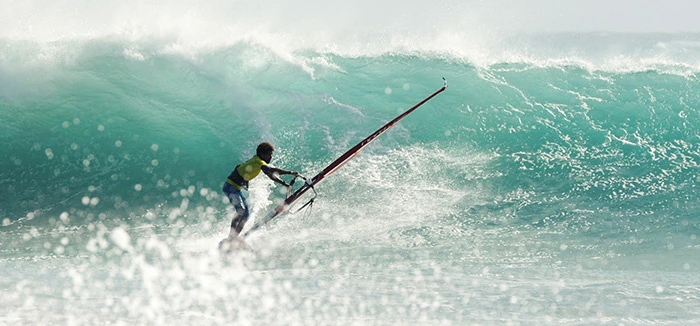
Tras Leão (aka Secret Spot or Little Hookipa)
Like Cural Joul, this spot is one of the first to get some waves when the swell is from the North-West. But, unlike Cural Joul, this one is really safe! This spot is so likely to have some waves that it was the backup plan for the PWA competition in case Ponta Preta didn’t work. As Ponta Preta worked perfectly, this spot is still almost undiscovered. Tras Leão, which literally means ‘behind Monte Leão’ is one of the easiest spots on the West Coast. The wind is usually side to side-off and the waves are generally small to medium sized. You just need to be more careful at low tide with the reef on the right of the spot as there is very little water and the floor is paved with coral and sea urchins.
Monte Leão
Monte Leao is usually a surf spot but when the wind comes from the north-west it becomes a nice windsurfing spot. The wind is a little gusty because of the mountain but it’s the only spot where the waves are not spoiled by the wind, which is onshore everywhere else on the coast. The spot can get busy with surfers and you will have to share the waves with them. The bay is also a great spot for free-riding, with flat transparent water. And if you have any non-windsurfers in your party, this beach is beautiful, empty and protected from the wind and a good place for snorkelling.
Canoa
A few years ago the Itoma catamaran discovered this spot. Since then it has become more and more crowded as the various centres send their more experienced clients here. There are a lot of advantages to this spot. Firstly, the wind is often stronger here than at any other spot. Also there is a small beach to launch from. But most of all, the waves are not too powerful here – even when they are logo to mast high. There is a long, large wave on the left, not too powerful and breaking in different sections. There is also a clean, shorter wave on the right of the spot which can break very nicely.
Calheta Funda (aka Rife)
This spot used to be the one where the centres go for their ‘windsurfaris’ on the west coast until everyone switched to Canoa which has easier access. So while everyone else is riding at Canoa, you can catch some really good waves here, just you and your friends. You launch from a good sandy beach a few hundred metres from the waves. The wave is fast and ends with a nice hollow bowl, perfect to improve your aerial skills. Also, as you have plenty of flat water to accelerate, it’s a very good place for jumping.
With all these great spots for different levels of experience and different skills, you have probably already chosen a few you definitely want to check but one other cool thing to do is a mini-trip between Calheta Funda and Ponta Preta. It’s done downwind, so you can surf waves without even caring about the need to go back o your starting point!
Downwind Calheta Funda – Mini Trip
If you decide to go for this mini-trip, remember that you need to double check your kit, bring some additional ropes and drink a lot of water. And of course, never do this on your own. We often organise group mini-trips when the conditions are right so keep an eye on the board at the centre.
La Esquerda
La Esquerda, literally ‘The Left’, is one of the world’s most powerful waves. Although it doesn’t have the consistency of some other top surfing waves, it is generally considered the Banzaï Pipeline of the Atlantic. In order to windsurf La Esquerda, you need a big swell with a south-east wind, which is rare. In the movie ‘Windsurfing Cabo Verde’ (available from us at the centre or online before you travel) you can see Josh riding this wave with side-shore southerly winds, which makes the wave face ugly. Anyway, with the trade winds, it is possible to ride the other side of La Esquerda, it’s right, and conditions for this are far more common. The tide has a very important impact on the way the wave breaks, so take your time to observe the wave before going on to the water. In many cases the wave ends on the rocks, which can be dangerous – especially for your kit!
To windsurf this wave you need to start from Ponta Preta and go upwind.
Ponta Preta
OK – ta da!!! Here we are! Ponta Preta is indisputably the star of the Cabo Verdian waves and for several reasons: First of all, the wave is perfect: big, powerful, glassy and nicely curved by the light offshore trade winds. And, in contrast to other waves like Ali Baba or Cural Joul, the wave is a walking distance from Santa Maria and breaks just a few metres in front of your audience and photographers!
That’s the good points. Unfortunately there are also a few bad points. First of all you have to get through the shore break, which is risky because the wind near the beach is often light and gusty. You need to be very patient and wait for a quiet period – sometimes up to 20 minutes! Then, the wind is quite offshore which makes it difficult to catch the wave and the wave breaks just in front of the big black rocks which give the spot its name – literally, ‘The Black Point’.
And, last but not least, you will have to share the waves with other windsurfers, kiters and surfers and even the occasional SUP. Surf rules apply here which means that the rider closest to the wave’s peak has priority. If a rider with priority in already riding the wave, do not attempt to catch the wave if it will place you in his path. This is the number one rule and breaking this rule is the biggest cause of altercations and accidents among riders in the water.
Everyone breaks his gear the first time he sails here. It will cost you your mast and probably your sail, and may even damage your board. Jason Polakow broke 6 complete sets of kit in one day here and several windsurfers even break their stuff in the shore break so never even make it to the wave! So – think carefully before windsurfing here. Even if there are a lot of people on the water, that doesn’t mean it is easy as they a mainly professionals of local experts.
East Coast
The wind on the East Coast spots is port tack onshore to side-onshore. The waves are usually not too powerful and the spots are safe.
When there is no swell but medium to strong wind, this coast can catch some rather good wind swell. Generally the conditions are more or less like Europe… But with sun, turquoise warm water and trade winds!
Until recently this coast was not ridden. It’s probably because there is already a lot of side shore and side-off shore spots elsewhere on the island, but also because there are some sharks here. After a few years of water-starting on these beaches, we now know that there is no danger and that sharks prefer fish and turtles! But even if there has never been an accident, you do need to be aware and take the necessary precautions, like not going in to the water after it starts to get dark or when you are bleeding!
At these spots you may well encounter turtles. They used to come on to the beach to lay their eggs but more often you will see them in the water.

1. Cabessa de Salinas
Before being ridden this beach was referred to as Shark Bay. It is now known as Kite Beach, partly because it is a less scary name but also because there are a lot of kite surfers here, but its real, local name is Cabessa de Salinas or Cabessa for short.
Several years ago, people used to put marks on the dune to be able to easily locate the place. Now it is no longer necessary because there is a large ap in the dune and a track to get there. Any taxi or pickup will know how to take you there. If you are on your own you will still be able to find the place easily as there is almost always someone there.
The spot is just in front of a reef. When the tide is low, there is almost no water on it so be careful! The waves are just downwind of the reef. When the waves are bigger it can be difficult to pass them. Take a bigger sail and stay right next to the reef. The more you go downwind, the more you may have problems going through the waves. When the waves are even bigger the best conditions are at high tide when the waves are cleaner.
The waves are a way out from the beach, which lets you get up to maximum speed before you get to them. This makes Cabessa a great place for jumping. When the wind is stronger, it usually comes from the North. It’s more side shore so front-side surfing is easier but the reef area is then protected by the mountain and the wind is more irregular.
In spring and autumn when swells are less frequent but the wind is sometimes strong, Cabessa can be a very good spot and offer you some great wave riding sessions.
2. Upwind Cabessa
If you are afraid of sharing the spot with too many kiters or if you prefer to avoid the crowd, you should consider going a few kilometres north of Cabessa.
There is almost nothing there but a small house, which belongs to Ducas and his family (hence the Dubel name). The waves are usually smaller yet cleaner here than at Cabessa and the wind is more side shore. Unfortunately, as the place is closer to the mountain, the wind is not as strong and regular as Cabessa.
3. Sierra Negra
There are other spots on the North East coast, rarely ridden and some still waiting to be discovered. If you continue on the beach after Dubel you will arrive at Sierra Negra where there is a small island and a starting point for a free-riding session far away from civilisation. At this point you can’t continue along the coast any further and you have to retrace your steps to be able to head north again.
To explore the other spots on the East Coast you have to go by car to Pedra de Lume and then go south. You may not run into a world-class spot there but you will definitely find a spot where you will be alone with just your friends.
Useful tips about the spots (and other travel info) can also be found here (in italian, but you can translate with Google): http://www.riwmag.com/corrado-avagnina-il-natale-capoverdiano-a-sal/
As for renting equipment, or taking windsurfing lessons, you also have ION CLUB, at Santa Maria ( https://www.ion-club.net/santa-maria/ ), or Kite and Tonic ( https://kitetonic.com/ ), at Santa Maria, but on the beach facing west.
The air temperature, in winter, ranges between 18/20 °C, as minimum, and 28/30 ° C as highest values (hard life....). Therefore, during the day, you just wear a bathsuit and a T-shirt, and, in the evening, maybe you need a sweatshirt. In the water, the ideal wetsuit is the 3/2 mm.
General info about Sal and its culture (Source: https://www.angulocaboverde.com/sal)
Sitting in the Atlantic Ocean, 500km from Senegal, the islands of Cabo Verde are waiting to be discovered.
Sal was discovered by the Portuguese in 1640, and named Llana, meaning ‘flat’. It was not until the discovery of salt, at the Pedra de Lume, that it took the Portuguese name Sal. Salt collection was central to the economy of Sal until very recently. Prior to the salt industry, the island of Sal was primarily used by residents from neighbouring Boa Vista for cattle grazing.
Sal is one of the ‘Barlavento’ or Windward islands and although it is volcanic in origin, constant erosion has left it flat and dry. The climate is invariably hot and arid. There is little rain fall, making it perfect for sun-seekers all year round. However, this does make the landscape pretty barren and not too much vegetation grows across the island. Most fruits and vegetables have to be imported from the other islands and further afield.
The seas around the islands are full of fish and the daily arrival of the fishing boats unloading their catch at the Town Pier in Santa Maria is a must-see.
The island measures around 30km long and 12km wide and the highest peak of Sal island is Monte Grande (The Big Mountain), at just 406m above sea level.
Sal is sprinkled with local style and international cuisine.
We invite you all to get to know the Cabo Verdeans – through their music, local dishes and artesanatos. Sal is sprinkled with local style and international cuisine, catering to palates of all tastes, the local seafood is usually still kicking it’s that fresh! In the evenings you can find local musicians performing at restaurants and bars. The “morabeza” or good vibes from the Cabo Verdean people are intrinsic to their deep history of song and dance. Many people only know Cabo Verde through the songs of Cesaria Evora – a beautiful mix of African rhythms and Portuguese melodies.
The Cabo Verde archipelago was uninhabited until the Portuguese discovered the islands in 1456. Enslaved Africans were brought to the islands to work on Portuguese plantations. They were joined by entrepreneurs and refugees fleeing religious persecution in Europe, leading to a rich cultural and ethnic mix. The uninhabited island of Santiago, founded in 1462 was colonised by the Portuguese, the first permanent settlement city in the tropics. Slaves were brought here from West Africa and by the 16th century Santiago was highly successful as the transatlantic slave trade flourished.
Cape Verde was part of the Portuguese Guinea (now Guinea-Bissau) and in 1951 the status of the Islands changed from colony to overseas province. The affirmation of the Cape Verdean Nation happened on the 5th July 1975 when Cape Verde finally gained independence from Portugal.
Today the influences of the West African and Portuguese heritage can been felt in the music, literature, the food and the language of the island. The official language is Portuguese, but most Cape Verdeans also speak a Creole dialect–Crioulo–which is based on archaic Portuguese but influenced by African and European languages.
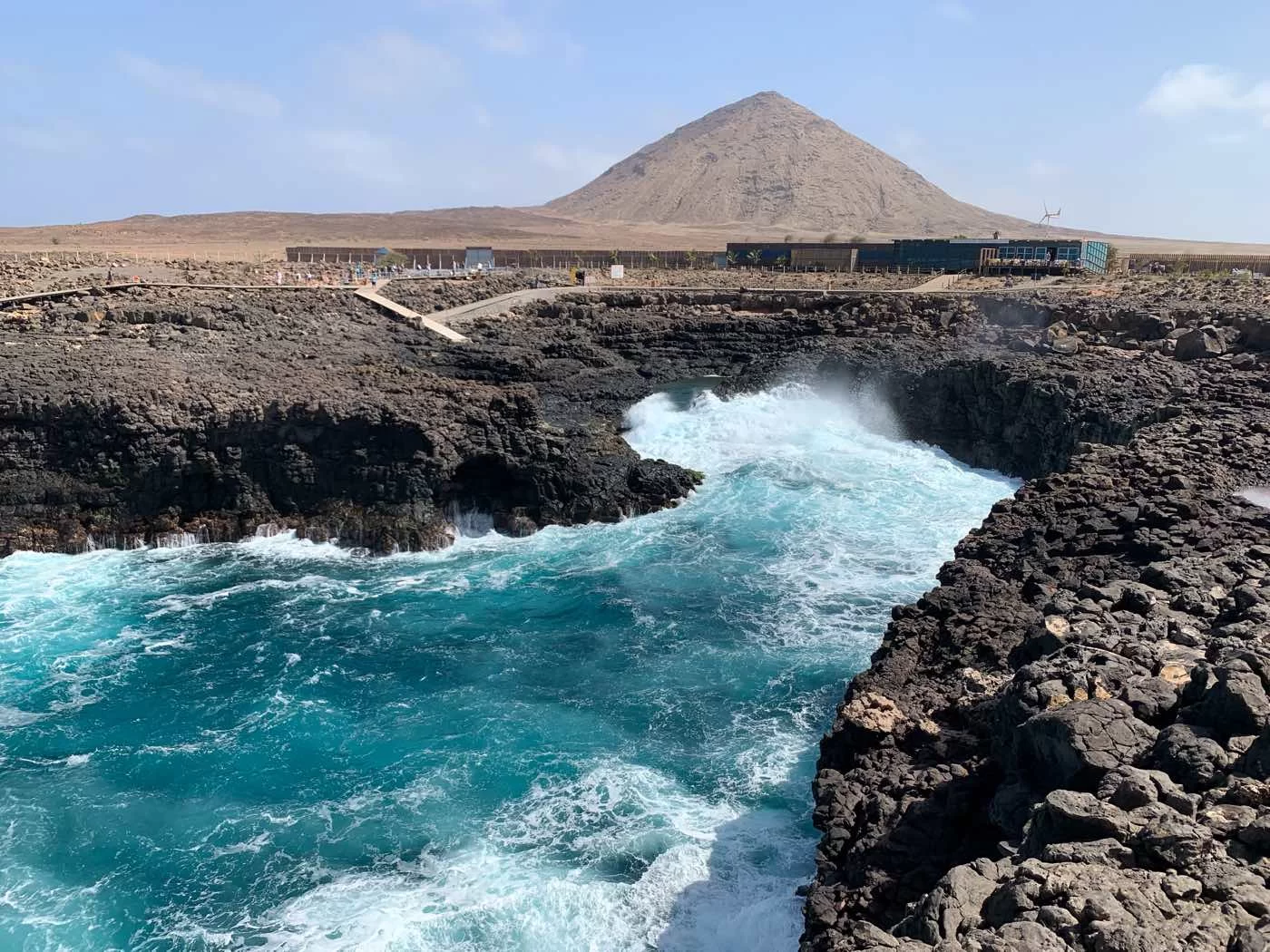
How to get there
You can get to Sal (Amílcar Cabral International Airport (IATA: SID, ICAO: GVAC), flying with TAP (Portuguese flag carrier) from Europe, with a stop-over in Lisbon. You have also low cost companies, as Neos (flying from Italy). Click here, and check this website for flight connections from Europe. It takes 6-7 hours to reach Sal by airplane, as average, from European countries.
Where to stay
Everybody stays at Santa Maria (on the South end of the island), because it's the most touristic village, with a wonderful beach, comfortable also for families in tow, with many accommodations available, and, most of all, closer to the main windsurfing spots. It's only 17 kms far from the airport, so it's a very short drive.
You can choose among many different possibilities for your staying. Beyond the already mentioned Angulo House, you have "Villa ao Mar", which is right on Santa Maria Beach, or Surfactivity Guesthouse, as well as more expensive hotels. Just have a look at booking.com , airbnb.com , or tripadvisor for further information.
Car rentals
You can rent a car at Sal Airport, but consider, if you land to Sal in the evening (as main flights from Europe do) that rental car companies shut their offices at 18,00-19,00. You also have rental cars companies at Santa Maria, where you generally take your accomodation. Prices range from 40 to 60 Euros per day.
Tips about what to see
There's not much to see and do in Sal, apart from water sports, and taking sun and bath, but if you want to have a trip around the island, you can get useful information at the following links:
https://www.geekyexplorer.com/sal-cape-verde/
https://www.tripadvisor.com/Attractions-g482847-Activities-Ilha_do_Sal.html
If you have any comments, post them below the article.
Have a nice journey, and a great time on the water.
Hang loose. Fabio Muriano
Some videos to make you understand what Sal is, from a windsurfing point of view, and convince you to go there
Pwa 2007 final at Ponta Preta: Kauli Seadi vs Josh Angulo
Another video taken at Ali Baba, Canoa, Secret, Ponta Leme
Some very nice videos both about windsurfing and places




